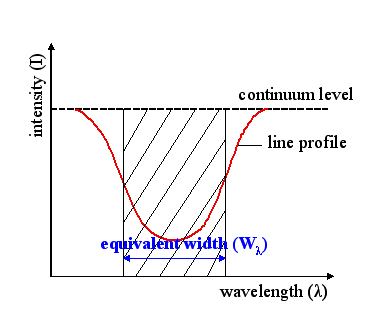 | ||
The equivalent width of a spectral line is a measure of the area of the line on a plot of intensity versus wavelength. It is found by forming a rectangle with a height equal to that of continuum emission, and finding the width such that the area of the rectangle is equal to the area in the spectral line. It is a measure of the strength of spectral features that is primarily used in astronomy.
Contents
Definition
Formally, the equivalent width is given by the equation
Here,
Applications
The equivalent width is used as a quantitative measure of the strength of spectral features. The equivalent width is a convenient choice because the shapes of spectral features can vary depending upon the configuration of the system which is producing the lines. For instance, the line may experience Doppler broadening due to motions of the gas emitting the photons. The photons will be shifted away from the line center, thus rendering the height of the emission line a poor measure of its overall strength. The equivalent width, on the other hand, "measures the fraction of energy removed from the spectrum by the line," regardless of the broadening intrinsic to the line or a detector with poor resolution. Thus the equivalent width can in many conditions yield the number of absorbing or emitting atoms.
For example, measurements of the equivalent width of the Balmer alpha transition in T Tauri stars are used in order to classify individual T Tauri stars as being classical or weak-lined. Also, the equivalent width is used in studying star formation in Lyman alpha galaxies, as the equivalent width of the Lyman alpha line is related to the star formation rate in the galaxy. The equivalent width is also used in many other situations where a quantitative comparison between line strengths is needed.
